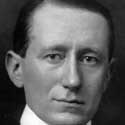"Every day sees humanity more victorious in the struggle with space and time." ~ Guglielmo Marconi
The inventor of wireless telegraphy, Guglielmo Marconi (1874-1937) was born on this day in Bologna, Italy and took an interest in physical and electrical science as a child.
At age 20, he was inspired by an article that discussed the possibility of using Hertzian radio waves instead of telegraph wires to communicate.
"Long experience has taught me not always to believe in the limitations indicated by purely theoretical considerations," he once said. "These, as we well know, are based on insufficient knowledge of all the relevant factors."
From the family attic workshop, the passionate young physicist immediately began experimenting with radio signals from one end of his house to the other. Soon he was sending and receiving electrical signals up to two miles away.
Applying for a patent in 1896, Marconi allowed the British Navy to install his equipment in some vessels. By 1901, seven years after his first experiment, Marconi transmitted signals across the Atlantic Ocean, from Poldhu, England to St. John's Newfoundland.
"It proved what I had known all along," said Marconi. "Radio could encompass the world!"
The "Father of Wireless" won the 1909 Nobel Prize in Physics for his wireless communications. He continued his experimentation and developed VHF radios during World War I and short wave signals in 1923.

